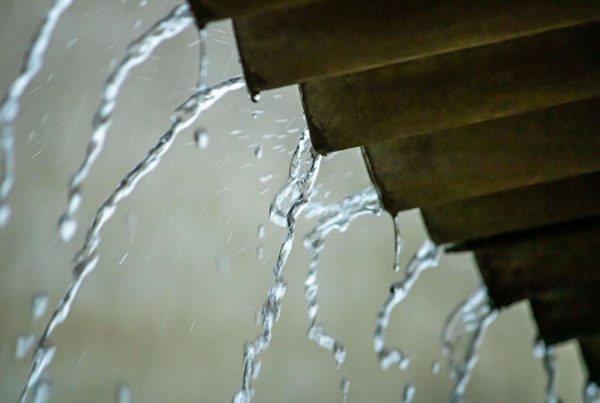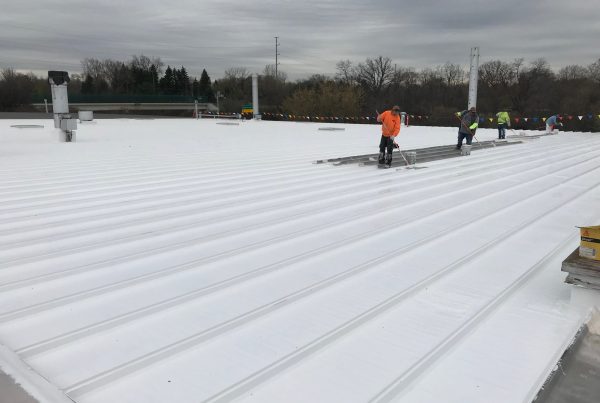Commercial Roof Repair & Replacement
The simple answer is – when it leaks.
Leaks indicate a compromised roof. That somewhere overhead there’s damage – a tear, a hole, a weakness, clogging, weathering, wear-and-tear. And while other indicators of roofing problems may be present, leaking – weather drips, seeps, stains, ponds, waterfalls, or mold (to name a few) – is a warning that should never be brushed off or ignored.
Let’s look at some of the factors you need to consider in determining what to do for your commercial roof, whether it be repair or replacement. For purposes of this discussion, we’re focusing on the flat roofs found atop apartment buildings, big box stores, factories, offices, strip malls, warehouses, and similar commercial structures.
Figuring Out What’s Wrong and Why
This is not always as easy as it sounds. Although some causes are obvious, like a natural disaster punching holes in the roof or seams pulled apart by weathering and age, other problems are much tougher to find. Minute tears in the roof surface are a good example. These tears are difficult to see, but they let water get through. And water is sneaky. It can run under a ceiling or flow along a pipe until it shows up far from the point of penetration.
The best advice is to consult with a qualified, experienced professional who understands everything about how and why roofs work. Applying expertise developed through years of experience, industry training, and local knowledge, he or she can pinpoint your issue and work with you to develop solutions for your commercial roof whether it be repair or replacement. Sometimes a repair is as straightforward as freeing up a blocked drainage system or fixing flashing around a vent. In other instances, a roof is just plain worn out. Aging is the single biggest reason a roof needs to be completely replaced.
Determining the Type of Roofing Material
On commercial structures, single-ply membrane systems are the most common material. These consist of a sheet of rubber or other synthetic substance secured to the roof frame and decking. Each of the three types of single-ply membrane roofs comes with pros and cons.
- EPDM (ethylene propylene diene terpolymer) roofing is a single-ply rubber material that’s versatile, lightweight, durable, and easy to install and maintain. Reflective of UV rays, flexible in colder temperatures, and resistant to leaks and punctures, EPDM saves on energy costs and lasts 25 to 30 years.
- TPO (thermoplastic polyolefin) can be installed over almost any surface and is resistant to mold, hail, wind, fire, and air pollution. Reflecting heat makes TPO energy efficient. Life span is 15 to 20 years.
- PVC (polyvinyl chloride) offers excellent energy efficiency throughout 20+ years. Made of multiple layers of PVC and polyester, PVC roofing is durable and flexible, especially in fluctuating climates and varying natural settings. It is also fire-resistant, recyclable, and eco-friendly.
BTU or built-up roofing is another option. This tar-and-gravel concept has been around for 100 years. Surfaced with gravel or stone, Bitumen Thermal Units consist of alternating layers of bitumen (asphalt) and ply sheets. Installation can be time-consuming, although the sealed surface is waterproof, energy-saving, and good for 15 to more than 30 years.
Another important consideration is decking .Decking can be wood, metal, or tectum composite. Condition often can’t be determined until a job is underway. Repair or replacement may be needed because quality decking is just as important as good materials and solid workmanship to longevity and durability of your roof.
Clearly, roofing gets very complicated. This is why sorting out options with a roofing professional is so important. The best choice for another building may not be appropriate for your structure, and you need to know why. Your roofing consultant can assist you in understanding every aspect of your project, including the investment required.
Estimating the Cost
Repairing or replacing your roof is a big investment. How big depends on lots of factors in addition to the ones mentioned so far. Among them:
- Size of your building and what happens there. The heat and vibrations of a factory making trucks puts very different stresses on a roof than kids coming and going to elementary school, and roofing must take that into consideration.
- Accessibility of the rooftop. The taller the building, the more difficult getting workers and materials to and from the job site becomes. Difficulty costs.
- Number and types of penetrations. Openings and flashing for installation of ducts, drains, HVAC, chimneys, plumbing, skylights, and vents are part of building function and roofing plan. More openings mean more money.
- Building codes. State, regional, county, and city requirements for everything from fasteners and fire resistance, to weather durability, energy efficiency, and wildlife interactions, must pass inspection and meet code. The stricter the code, the higher the price of compliance.
- Protection and disruption. During construction, the people in your facility must be shielded from equipment, injury, noise, and odors. That may translate to lost production, which equates to cost.
Anticipating use, expansion, remodeling, and other changes to the property 2, 12, 25 years out impacts the roofing decisions you make today. Plus, the cost of materials and labor continues to go up, so acting sooner rather than later may save you money in the long run.
Thinking EUL
That’s estimated useful life … essentially, the bottom line.
To protect your investment, the roofing solution must be appropriate to your situation and structure, taking every item mentioned here, and more, into account. Expert installation by experienced crew using top-quality materials is essential. Inferior workmanship can compromise warranties. Be sure you know what your warranties cover and for how long. Stick to a schedule of regular inspection and maintenance. Even the best roof won’t take care of itself.
Patching, repairing, or replacing your commercial roof is a complex process with lots of variables. The goal is getting maximum useful life from your venture, making sure your roof lasts a long, successful time.



